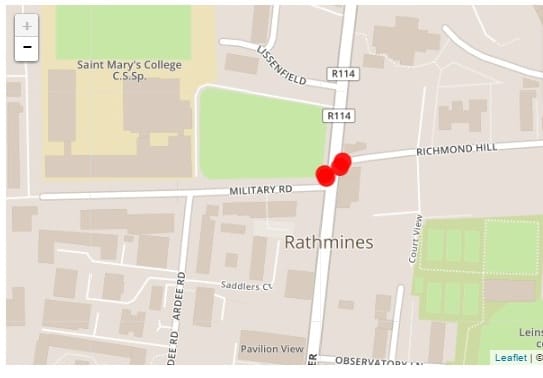What’s the best way to tell area residents about plans for a new asylum shelter nearby?
The government should tell communities directly about plans for new asylum shelters, some activists and politicians say.
We’ve found an intersection in Rathmines that could do with some adjustments to make it safer for cyclists.

“This is definitely an awful junction,” says Colm Ryder of the Dublin Cycling Campaign.
It’s a spot where three collisions have been flagged on our cycle-collision tracker map, one reported as serious, and another as a near miss.
It is 3:30pm and we are stood in the rain at the corner of Rathmines Road and Military Road. As we watch, a stream of cars head out from Cathal Brugha Barracks and awkwardly jig through Rathmines Road before making their way east on Richmond Hill.
The staggered nature of the intersection means that such a movement requires a quick left turn onto Rathmines Road, before a quick right onto Richmond Hill.
“All that area is very residential,” says Ryder, pointing down Richmond Hill, “but look at the amount of cars that are taking it.”
Ryder says it’s a bit of a rat-run. Most the people heading east onto Richmond Hill are likely doing so because they can’t turn right off of Rathmines Road where it meets the canal. Up there you’re only choice is to go straight across Portobello Bridge, or left onto Grove Road.
“There are people trying to do all kinds of weird manoeuvres,” said Ryder, as we watched cars trying to get across traffic on Rathmines Road.

Cars were starting to stack up in the middle of Rathmines Road, trying to turn right onto Richmond Hill. “When they see something they’ll jump for it because they’ve been waiting a while. It encourages people to do crazy things,” says Ryder.
For two of the three men who wrote descriptions of what happened, cars “jumping” for the right-hand turn were at fault.
One said he was struck badly back in 2012: “I was cycling towards the canal and a man coming from the canal end turned up the military road in front of me without indicating and I was hit badly. Bad injuries as a result.”
The second respondent was a bit luckier, reporting a near miss as he travelled in the other direction.
“A car in front of me had stopped at the yellow box with Richmond Hill to the left, and the car in the opposite lane took this opportunity to take a right hand turn into Richmond Hill. I didn’t see this turning car from my vantage point in the bike lane, and as I cycled along the bike lane the car broke through the junction and missed me by inches,” he said.
Although this man says he technically had the right of way, he always approaches the intersection with more caution now, adding that cars should inch out into the cycle lane as slowly as they do into the bus lane.
Ryder points out that cars travelling towards Rathmines Road on Richmond Hill routinely inch out into the cycle lane to get a better look at traffic.
A car inching out into traffic on the Rathmines Road is exactly what sent the third cyclist “over the bonnet,” according to the man’s entry into our bicycle-collision tracker.
This problem might have an easy solution. Ryder points out that there is a complete dearth of road markings that might help bring the cars to heel.
“There is no stop line, the only line they see is that yellow box,” says Ryder, “so they’re going right up to that.”
Ryder also points out that the Military Road is very wide where it meets Rathmines Road. And the road’s wideness and lack of stop lines signals to cars that they can feel free to come right up to the flow of traffic, and not to worry about letting pedestrians cross in front of them or being mindful of cyclists.
If Ryder were to redesign the junction, he would narrow it considerably and simply put clearer road markings that signal to cars that they have to stop to allow pedestrians and cyclists to pass.
As well as further research into the possibility of installing a traffic signal or what the effects of closing Richmond Hill to through traffic would be, Ryder thinks Rathmines is a prime candidate for a 30 kph speed limit.
“This area, as far as we’re concerned, should be one of the 30 kph zones. It’s a village area with a lot of pedestrian traffic,” says Ryder. “That’s the kind of thing that needs to be looked at.”
Get our latest headlines in one of them, and recommendations for things to do in Dublin in the other.